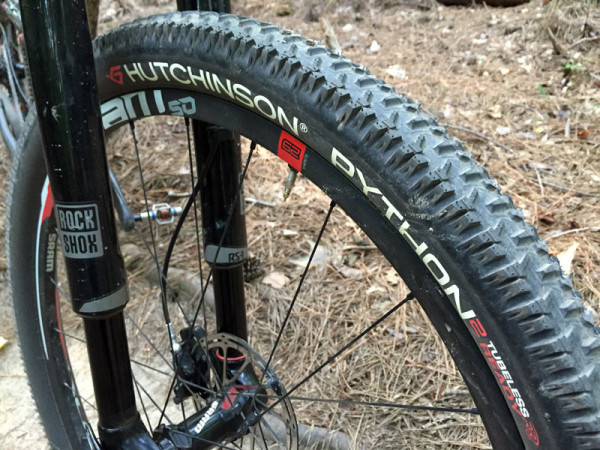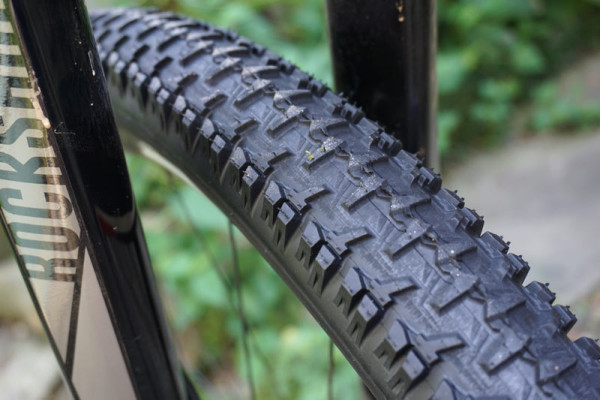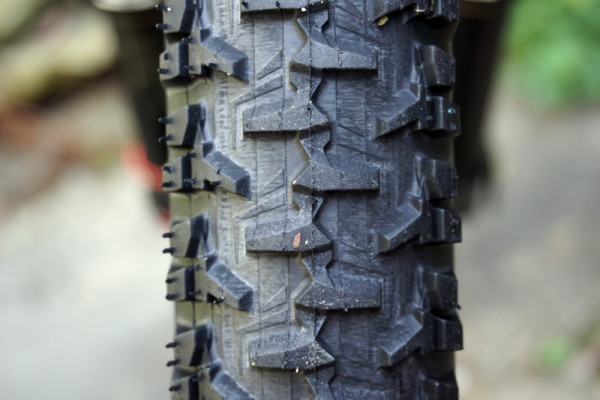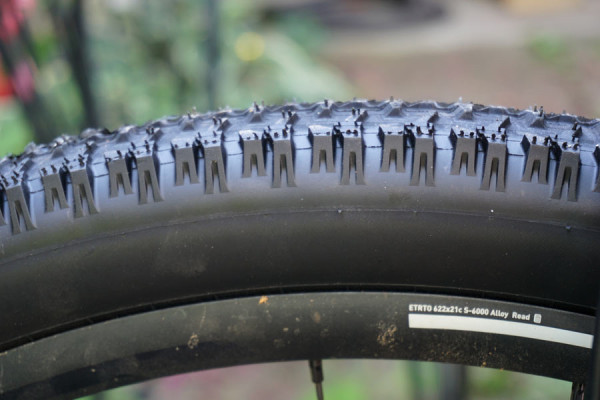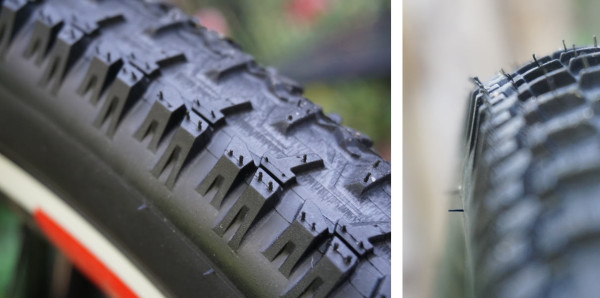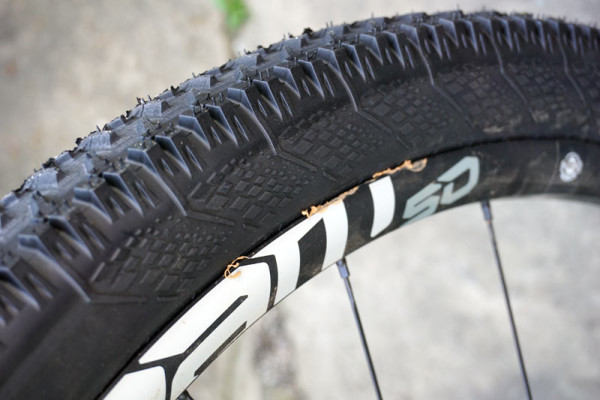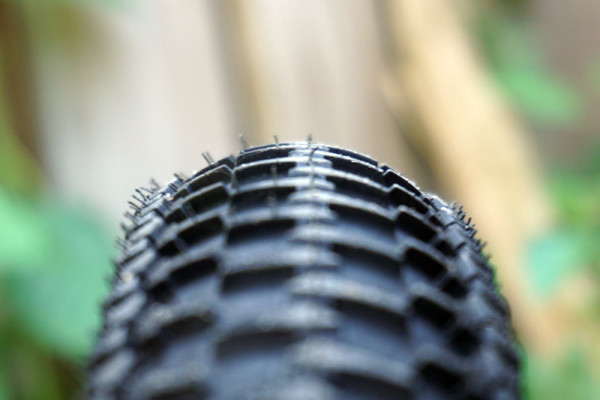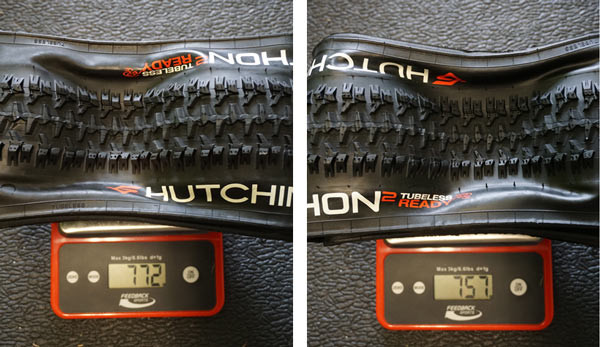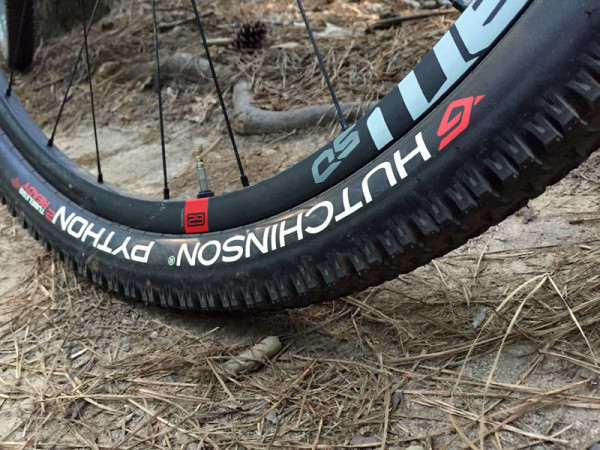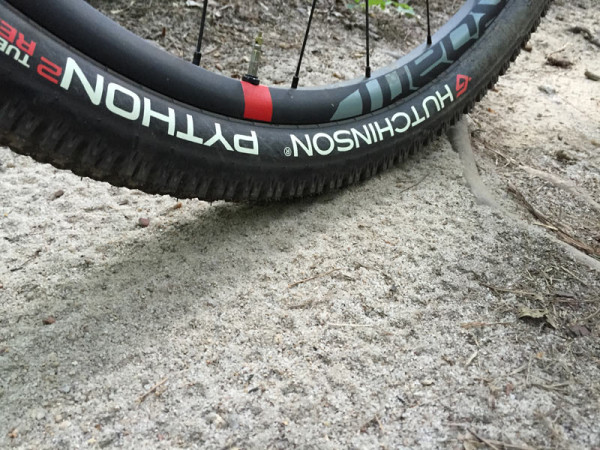If any tire has stood the test of time, it’s the Hutchinson Python. After a 20 year run, the French company reworked the tire with updated rubber compounds, casings and a familiar but improved tread pattern and showed it to the world at Eurobike last year.
Now, we’ve got our hands on a set, threw them on the scale, then hit the dirt. And sand. And some pouring rain. In the course of my first three rides, I experienced lightly moist dirt, bone dry dirt and water running down the trail after being caught in a thunderstorm wet. And with a couple caveats, those rides elicited all the gushing memories I had of my eager racing days aboard the original Pythons…
Anyone that’s been riding for more than ten years would instantly recognize the Python’s distinct alternating tread pattern. The center knobs are now ramped and connected by a small, zigzaggy spine to help maintain rigidity. The image above looks backward, but the tire would roll counterclockwise to go forward, putting the ramped edges at the front of each knob.
The center knobs’ tight spacing makes for fast, quiet rolling, even on pavement. While the transition knobs look like they’re aimed backward (they are), they make an evenly spaced connection from center to side knobs, helping maintain even traction as the bike is leaned. And it worked, providing consistent, reliable traction all the way into a hard corner.
The side knobs are heavily reinforced to prevent them from squirming under pressure. The tight spacing made it feel like they didn’t dig into the trail quite the way a spiky knob would, but they held their ground just fine.
The side of the outer knobs runs almost straight upward. If you typically lean your bike to extremes, maybe look for a tire with knobs that more closely follow the contour of the tire. But for this tire’s XC intentions, they seem to work very well at providing the necessary traction while maintaining rolling speed.
Grabby ramps adorn several patches along the sidewall while other sections are smooth as a baby’s behind.
The profile is pleasantly plump for the 29×2.25 Tubeless Ready XC casing tires, hence the smooth, even transitino into a corner. These are mounted on SRAM’s Roam 50 alloy 29er wheels (21.5mm internal width, 26mm external, both from my own measurements).
Those rims put the tire width at about 2.15″ (54mm) at the widest point of the casing and 2.1″ (52mm) at the widest point of the tread. That’s certainly narrower than the 2.25 claimed width. Considering the tread design and the near vertical sidewall shaping, I don’t think a wider rim would improve the tread’s width. In fact, if the tire’s profile were flattened across the top from a wider rim, I think it could actually diminish the overall performance.
The tires carry a claimed weight of 760g, so at 772g and 757g they’re on target.
My first ride was on some great tacky dirt as the trails recovered from a light drizzle the day before. Unfortunately, the tires were still learning how to hold air, dropping 10psi over 20-30 minutes of riding and requiring several mid-ride top offs. This led to unpredictable handling and landings, which led to timid riding.
Day two saw the rear doing much better, only dropping a couple psi overnight, but the front got a second dose of Stan’s sealant. That held the losses to about 7psi over a 2 hour ride, and by the third day of riding it seemed to have sealed itself up. They both dropped a couple psi over the third ride, but not enough to change their handling characteristics. For my 185lb person (without clothes and gear, probably close to 200 fully kitted out with Camelbak), 24-26psi seems to be the right mix of traction and compliance without squashing them to the rim on landings and G-outs.
On trail conditions shown above, which were very dry but with matted tree debris strewn across sections, traction was fantastic. And the tires rolled oh so easily and quickly.
On the ultra dry oversized sandbox particles that lay over cement hard base layers, the tires were challenged to hold on during high speed corners…but, honestly, everything else is, too. What’s nice about the Pythons on this type of surface and similar is they don’t grab the sand/dirt/whatever and fling it upward at the rider. Other tires I’ve ridden send a constant spray into my shoes, but these leave the dirt where it belongs.
Thanks to a midnight soaking, this same trail started in perfect, hero dirt condition the next day for the first 40 minutes, then went to submerged for the second 40 minutes back to the car thanks to our usual afternoon summer thunderstorms coming early. Roots that were just barely glistening became soaking wet, but the Python2’s grabbed on anyway, especially in straight line climbing. Whether seated or standing, I didn’t spin the rear tire once on a wet root. Even cornering (albeit slower than normal) on the wet roots was surprisingly good, with only minimal slipping.
Braking performance is impressive, too. Only once did the rear tire skid unintentionally. All other braking efforts were perfectly controlled.
Hutchinson offers the tires in 2.1 and 2.25 widths in all three common wheel sizes (26/27.5/29). Four casings are offered – 33tpi and 66tpi tube-types, the 127tpi tubeless ready XC tire tested here, and tubeless ready “Enduro” version that uses a dual 66tpi casing. The latter adds a couple hundred grams per tire thanks to the thicker reinforced casing. Personally, it might be good for a dry course as a rear tire during true enduro-level fun, but this tire shines as an XC to trail tire through quite a range of conditions. Actually, even Hutchinson primarily recommends this tire as a rear, suggesting the Cobra or Cougar for an XC front (and Toro or Squale for enduro), but so far it’s working very well up front on my Niner JET9 (100mm travel front and rear).
We’ll check in again this fall after they’ve been worn in and the trees begin shedding their leaves.
